This was published 6 years ago
Salamanca: Spain's 'Golden City' is an idyllic small city of good food, history and culture
By Mark Chipperfield
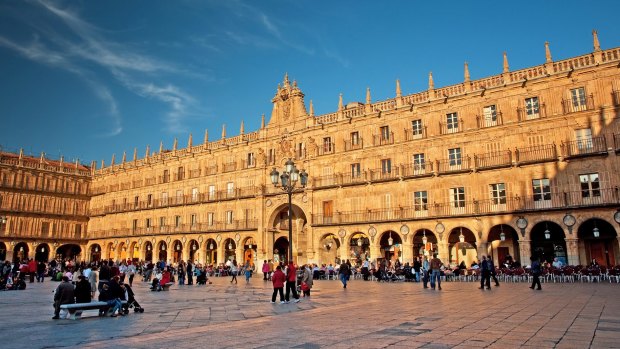
Plaza Mayor, Salamanca, is a magnificent 18th-century town square which was built to host epic bullfights, the last of which was held in 1992.Credit: Shutterstock
Until stepping into Salamanca's Plaza Mayor, a magnificent 18th-century town square built to host epic bullfights, I'd always regarded San Sebastian as the most idyllic of Spain's many historic small cities.
Unlike its northern counterpart Salamanca does not come with surf beaches, cider houses and an international film festival, but more than compensates with splendid architecture, elegant streets and mouth-watering cuisine.
Known throughout Spain as "The Golden City" because of its honey-coloured sandstone, Salamanca has the distinction of hosting Spain's oldest university. Founded in 1134, the University of Salamanca is the third-oldest university in Europe, after those of Bologna and Oxford.
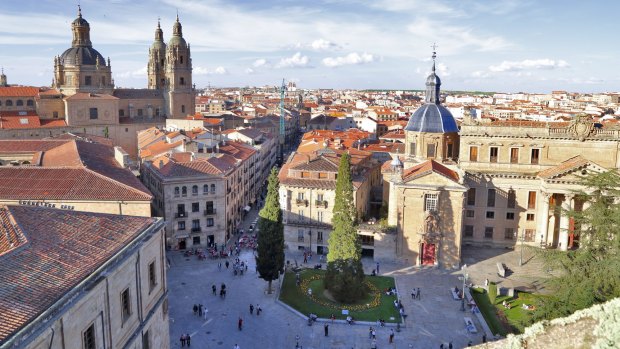
Salamanca is home to Spain's oldest university. and because of its honey-coloured sandstone, it is known as "The Golden City".Credit: Shutterstock
"The university was granted a royal charter by Alfonso IX of Leon in 1218," explains my guide Christina. "So next year marks 800 years of continuous operation. As a citizen of Salamanca I am incredibly proud of that."
Plans are well under way for a host of celebrations to mark this important milestone, so 2018 will be an excellent time to visit this spotless medieval city which traces its origins back to Roman times, was sacked by Hannibal and later conquered by the Moors in AD712.
The University of Salamanca quickly established a reputation for its secular curriculum, which included law, philosophy, economics and the humanities. Christopher Columbus once gave lectures here about the New World, while its long list of alumni includes the writer Cervantes.
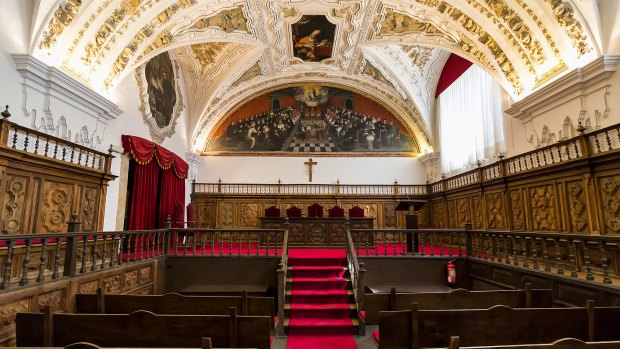
A meeting room at the University of Salamanca, which was granted a royal charter by Alfonso IX of Leon in 1218.Credit: Shutterstock
"When the university was established law was the most important college, not theology which came much later," says Christina. "We follow the example of Bologna, not Paris and Oxford. And for that we can thank our kings."
Salamanca remains, at heart, a university city. About a fifth of its 160,000 strong population are students – although most of them now attend modern campuses on the perimeter, far from the medieval cloisters of the old city, listed as a UNESCO World Heritage Site since 1988. "By most standards Salamanca is a small city," says Christina. "But the big student population means that we are an ambitious, outward-looking city. Students come from all over the world to study here."
Drawcards
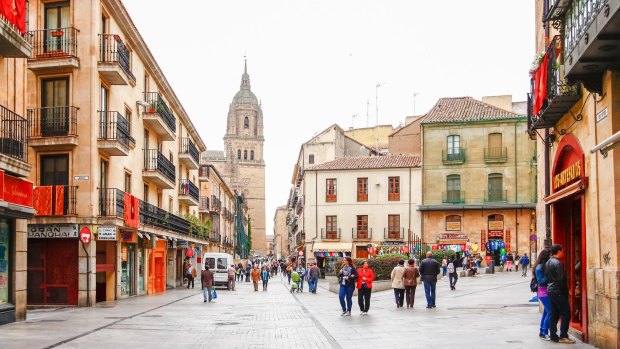
The Cathedral of Salamanca, which is two churches joined together, is a major drawcard to this university city.Credit: Shutterstock
While the elaborately carved façade of the old university, completed in 1433, remains one of Salamanca's main drawcards, it competes for attention with the city's two cathedrals (one Romanesque and the other from the late Gothic period) and its celebrated Roman bridge, Puente Romano, which is displayed on the city's coat of arms.
For a city that dates from pre-Christian times, Salamanca wears its history lightly. As you join the holiday crowds in the Plaza Mayor or sample the jamon iberico in a back-street delicatessen, it's hard to imagine that Hannibal and his elephants once ruled these parts, having put the Roman Legions to the sword, or worse.
While most visitors are attracted by its rich architectural legacy and a collection of cultural institutions, including the fabulous Art Nouveau and Art Déco Museum and the whimsical Museum of Automotive History, Salamanca is also a showpiece for the distinctive cuisine of central Spain – a region renowned for its fine beef cattle, high country cheeses, wild game, figs, cherries and strawberries.
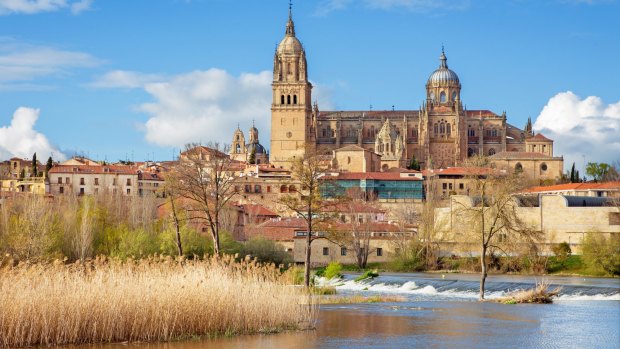
The Cathedral sits above the Rio Tormes.Credit: Shutterstock
No visit to Salamanca is complete without getting your chops around a slice of hornazo, a baked pastry stuffed with ham, sausage, bacon and egg. Other local specialties include cochinillo al fuego (roasted suckling pig), farinato (white sausage) and chanfaina salmantina (a stew made from trotters, rice, sweetbreads and chorizo). You'll also find a wide range of almond and honey desserts – most inherited from the Moors who controlled the city during the 8th century.
Visiting gourmets will find plenty of tapas bars in the old city, but if you fancy a bit of people watching walk over to the city's expansive Plaza Mayor. The last bullfight was held here in 1992. Today, the square is home to bustling pavement cafes, up-market jewellery stores and gelato bars – the grand upstairs apartments are now owned by some of Salamanca's wealthiest citizens.
"The Plaza Mayor is our living room," says Christina. "This is the place we still come to walk in the evening. There was a long tradition here that the women would walk in the clockwise direction and the men would walk in the anti-clockwise direction, but today we walk together."
TRIP NOTES
MORE
FLY
Etihad Airways flies frequently from Melbourne, Sydney, Perth and Brisbane to Switzerland, with onward connections to Porto aboard local carrier TAP. Cruises depart from downtown Porto, 11 kilometres south of the airport. etihad.com
CRUISE
Scenic's 11-day "Unforgettable Douro" cruise sails from Porto along the Douro River to Vega de Terron on the Spanish border and includes a day trip to Salamanca. Guests can choose from a wide range of shore experiences, such as guided city tours, signature dining events, wine tastings and canoeing expeditions. Prices start at $7995 per person, twin share, for a standard suite. Tariffs include all meals and drinks onboard, shore excursions, complimentary mini-bar, free Wi-Fi, butler service, airport transfers and all tips and gratuities. For bookings phone 1300 742 859 or visit scenic.com.au
Mark Chipperfield was a guest of Scenic and Etihad Airways.
Sign up for the Traveller Deals newsletter
Get exclusive travel deals delivered straight to your inbox. Sign up now.